the caboose that never was
1234567




















1234567
Re: More C&S caboose under frame weirdness.
|
This post was updated on .
Looking back through this steadily developing thread, there is now at least one thing we can say with absolute certainty, based on the 313/Blackhawk photo. The modern 9 ft wheelbase undercarriage was not required in order to have Westinghouse brakes. At least one version of the short, 6' 3" wheelbase did have them.
Given this, and the supposition (proven, or not?) that none of the cars were born with the modern, independently sprung 9 ft undercarriage, then why did they get rebuilt with this undercarriage? If it was to improve their ability to stay on the rails as seems likely, then why was this done, to at least most of the cars, instead of putting them on trucks? After playing around for a minute with a pair of trucks and my model, it looks that it would be a very tight squeeze to get trucks with outside brake shoes under the short-bodied cars. Likewise, looking at the photo of Jim's beautiful 1002 two-truck model and scaling the body length down, I come to the same conclusion: the brake beams would not clear each other on a short-bodied car unless the trucks were moved further out to the ends of the car, and then the journal boxes would almost certainly interfere with the steps. By the way, I'm totally convinced by Jim's two-truck analysis of the 1002 photograph in the eight-wheel caboose thread. Interesting to see that he doubted his sanity after being forced to his conclusion, just as I did mine, with 313! So, maybe the modern 9' four-wheel undercarriage was the solution for the short-bodied cars, and then, the parts having been produced, was used under long-bodied cars as well. John
John Greenly
Lansing, NY |
Re: More C&S caboose under frame weirdness.
|
From a practical standpoint, I think you are spot on in your assessments.
As a builder and fabricator, I would also toss out the thought that ANYONE in the business of building stuff and keeping fleets in service is going to meet an arising problem with a little thought and experimental approach. I would submit that the inconsistencies are the result of a developed plan, where a new idea was tried, and perhaps adjusted to provide better results, based on how the first one performed. I would also submit that I often do this, some times leaving the original fix as-is, because it works good enough. Other times I will go back and redo the original "fix" with the improved idea/s because the results are too good not to upgrade. I doubt the C&S shops did it any differently.
"Duty above all else except Honor"
|
Re: More C&S caboose under frame weirdness.
|
This post was updated on .
In reply to this post by John Greenly
Interesting thoughts, John and SP.
There seems to be a new premise congealing as to the evolution of the C&S cabooses from building to abandonment. Lord knows if any of this is true or not. It might be helpful to summarize all the thoughts posted to date in terms of a timeline. Construction, 1880-1884: A total of 21 cabooses were built for the South Park, before and after the UP take over. The cars were delivered in four batches. Some had longer bodies than others. Photographs (very few) and a single surviving folio 27 drawing suggest that all cars were equipped with 4 wheel undercarriages with a short 6' 3' wheel base. We have no idea what the original undercarriage looked like; the photo of C&S caboose 313 in Blackhawk is not clear enough to draw conclusions. Maintenance, Repair, Remodeling, Replacement with New Building, 1885-1899: Over the years, the UP shops (including during the Trumbull Receivership) may have made major changes to the caboose fleet, while repairing wreck damage or rebuilding/new-building worn out cars. At least one, maybe more of the long body (14+ foot) cars were placed on four wheel 20-ton Peninsular type trucks. At least one of the short body (about 13 foot) cabooses had a new intermediate under frame with 9' wheel base constructed, perhaps an experiment to improve tracking/riding characteristics (this was 1511/308/1006, there may have been others). New construction also probably occurred; 1500/303/1002, a long body car, had a center cupola added, was remodeled with square windows and quarter round corners and was place on 4 wheel trucks. At least two other short body cars were extensively remodeled, perhaps new construction to replace vacated or scrapped cars (1507/306/1005 and 1514/310/1008): The cars had new center cupolas applied and the same square windows, quarter round corners as 303/1002; the new 9 foot wheel base intermediate undercarriage was also applied, and was photographed about 1901 (caboose 306) to confuse historians and model builders thereafter. (A contrarian argument is that 1002, 1005, and 1008 all came from the U&N during the early 1890's, but there is no written documentation to support this) At least one more short body car (see Como photo), perhaps others were remodeled with center cupolas. There is written evidence that automatic air brakes were installed on some cars in the late 1890's (the freight car fleet had sported automatic air brakes as early as 1884). Some cars were never rebuilt and remained pretty much in their original configuration when inherited by the C&S (see Braddocks photo). Automatic couplers replaced link-n-pin couplers by the fall of 1903. Modernization, 1908-1912: All surviving C&S cabooses had major rebuilding, with new under frames using heavy cast pedestals/journals and a 9 foot wheel base, perhaps inspired by the 9' wheel base intermediate under frames of the 1890's. Cupolas were moved to one end of the car, and windows reduced to one per side, most double pain, at least three remained single pane, square windows. Caboose 1002 never lost its center cupola, remained on 4 wheel trucks into the mid-teens (perhaps early 1920's), but eventually received the modern undercarriage. Amendments to the US Safety Act were issued in 1910, specifying lateral roof walks, end ladders and grab irons in specific locations. Some cabooses did not receive these upgrades until the mid 19-teens, others (perhaps rebuilt after 1910) had them added during the modernization rebuild in 1910-1912: Caboose 1003 (see photo above) did not have the new hardware in April of 1912, while 1007 had all the new stuff in July, 1912. A few cars likely never received the new hardware and were scrapped as surplus, given the declining traffic. Please critique this timeline by adding thoughts. And add any thoughts about the C.C./UPD&G cabooses as well; two cars (61/300/1000 and 62/301/1001) survived through the modernization phase, 1000 survived to abandonment. Caboose 1000 was a long body car, was 1001??
Jim Courtney
Poulsbo, WA |
Re: More C&S caboose under frame weirdness.
|
This post was updated on .
Jim, this looks great.
One thing-- with respect to the "intermediate" 9 ft undercarriage, I'm confused as to why you listed 308/1006 as having had an intermediate undercarriage. The 1006 folio shows a 9 ft wheelbase, but couldn't that be the modern undercarriage? I believe we have only the one photo of 306 with the intermediate version on the C&S and predecessors, and at the moment, no early photo that is inconsistent with the shorter 6' 3" wheelbase. But, we also have the two photos Doug Heitcamp has posted, of the mystery caboose and the Pacific Electric car, with what look like exactly the same type of undercarriage. So this type was probably a common design for four-wheel bobbers, and no surprise that the C&S or predecessor would have tried it out on 306. I would submit, using SP's line of reasoning (I also build experimental stuff for a living, and I agree completely with his point of view), that this experiment was found not entirely satisfactory, and indeed just looking at it, it doesn't inspire confidence about its mechanical robustness on the C&S's less than meticulously maintained trackage. Maybe this undercarriage was applied to other cars, but I believe our current information has nothing to say about that. Unless further information appears, it is quite possible that 306 was a single experiment, and was enough to show that this undercarriage was not up to the job. We have at this moment no reason from actual, contemporary evidence, to assume otherwise. Of course, there are all the modern drawings and models of DSP&P waycars, but…?! As to the modern 9 ft undercarriage design, and its eventual implementation on all the surviving cars, when did it first appear? Cheers, John
John Greenly
Lansing, NY |
Re: More C&S caboose under frame weirdness.
|
In reply to this post by John Greenly
John,
It bears a mention that the C&S shops built the double trucked Gilpin Caboose in Oct 1912.
UpSideDownC
in New Zealand |
Re: More C&S caboose under frame stuff--other narrow gauge bobbers.
|
This post was updated on .
In reply to this post by Jim Courtney
In trying to wrap my head around this new (to me) idea that the original South Park caboose underframes were short, wheel base just over 6 feet, I wondered if there were any 1880's narrow gauge engineering concepts that were standard to four-wheel caboose construction.
The only other Colorado narrow gauge bobbers that I could remember were the D&RG 4 wheel cabooses. They were built to a Billmeyer and Small design, and were the D&RG standard caboose from 1876 to 1885: 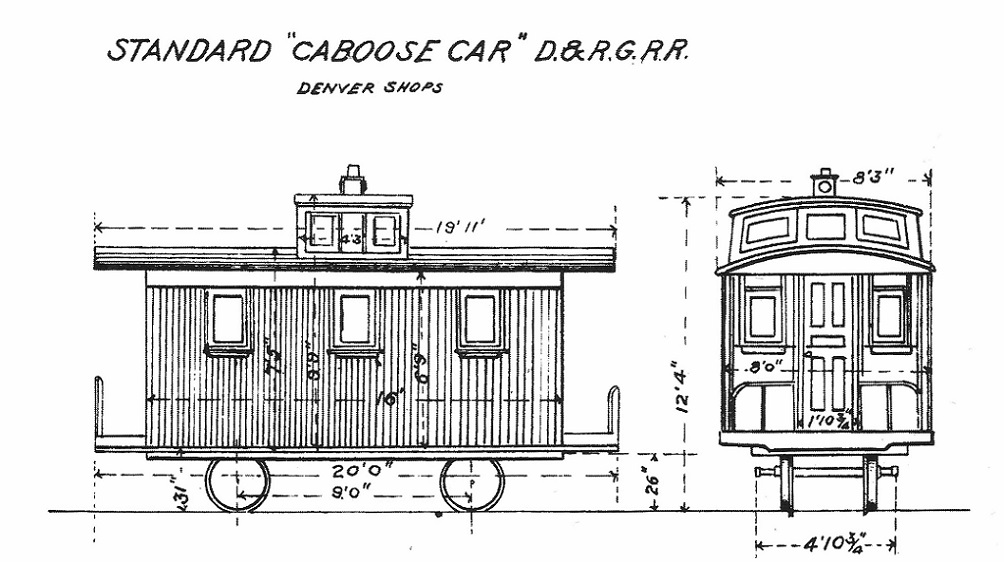 D&RG 1882 folio drawing, from Sloan, A Century + Ten of D&RGW Narrow Gauge Freight Cars . . . 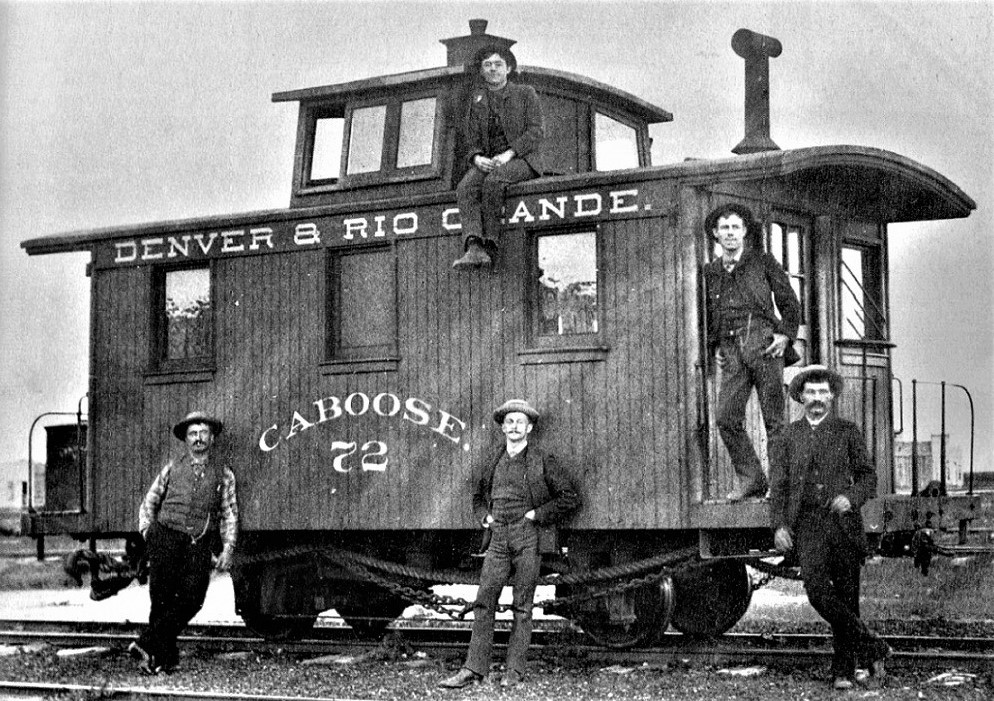 Colorado State Historical Society, in Grandt's Narrow Gauge Pictorial V Chris will note that stowing tow ropes and chains by wrapping them around the underframe seemed to be a standard operating practice of the 1880s. I can't see any standard relationship in the wheelbase (9' on the D&RG car) to body or overall frame length. The D&RG body was 16 feet as to 13-14.5 feet on the C&S. The overall frame length, over the end beams, was 20 feet, as opposed to the 17.75 foot frame length of the C&S short body cars. Using a wheel base to body or frame ratio for the D&RG car (0.56 and 0.45) the same ratios for a 13 foot short body C&S car would have yielded a proportionate wheel base of about 7' 3" to 7' 11" on the C&S bobber. So if the original South Park underframes were really only 6' 3" wheel base, they were proportionately much shorter than their D&RG contemporaries. The only similarities that I can see is to the "intermediate" version of the South Park under frame, as on the 306 photograph: Both had a 9 foot wheel base and a similar equalizer bar with central pivot. The C&S cars used paired coil springs on either side of the pivot point, in addition to the leaf springs over each journal pedestal. The D&RG cars lacked the center springs, using only the leaf springs over the pedestals. Is it possible that the UP shops used the D&RG standard underframe as the inspiration for the 9-foot "intermediate" underframes that were added to some cars before 1899?? ----------------------------------------------------- As an aside, my friend Geoff Hamway has emailed me that he has decided to stop being just a "lurker" here and has actually joined the Discussion Forum. Well, Geoff, here's an opportunity for your first post. How about sharing a photo of your beautiful Sn3 TOC D&RG 4-wheel caboose? As I recall, you used an Overland Sn3 C&S caboose underframe in the construction. Can you tell us how you modified the "modern" C&S undercarriage to the D&RG version, as it is similar to the earlier TOC C&S version??
Jim Courtney
Poulsbo, WA |
Re: More C&S caboose under frame stuff--other narrow gauge bobbers.
|
Jim,
the latercomer Uintah Railway had Bobbers.
UpSideDownC
in New Zealand |
Re: More C&S caboose under frame weirdness.
|
In reply to this post by Jim Courtney
Here's a complication.
Todd Hackett posted a good enlargement of a caboose at Beaver Brook on the CC on another thread: http://c-sng-discussion-forum.41377.n7.nabble.com/file/n6376/BB2.jpg here's the image: 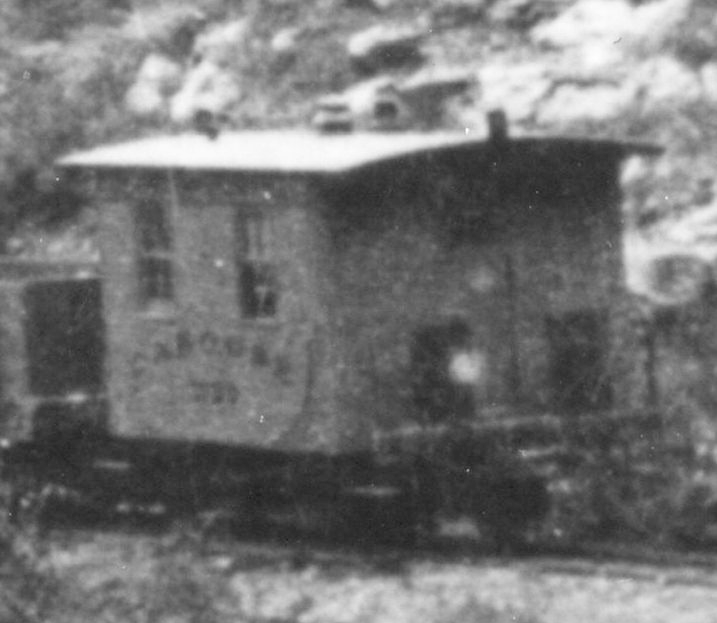 Only the near end wheels are unambiguously visible so the inference by my usual methods is not certain, but I believe this is consistent with a long wheelbase unless the car body is only around 11' long- unlikely. So, does this ruin our emerging timeline? In that thread, Jim very plausibly identified this as one of the two cars built in 1883 by the UP for the Colorado Central. Jim identifies this image as after the renumbering to 1725 or 1726, in 1885. So is it possible that these cars were built with, or had an early replacement to, a longer wheelbase, and are the exceptions that prove our new rule? Are there other useable photos of CC cabooses out there? John
John Greenly
Lansing, NY |
Re: More C&S caboose under frame weirdness.
|
John,
should you be considering that there is the possibility that the CC bobbers were built with the longer whb and were in fact the prototypes or testbeds for the DSP&P cars since by this time the UP is in charge? Just my early Monday morning musing on the matter.
UpSideDownC
in New Zealand |
Re: More C&S caboose under frame weirdness.
|
In reply to this post by John Greenly
And, how about this, another Clear Creek anomaly, this one in the C&S era, ca. 1905:
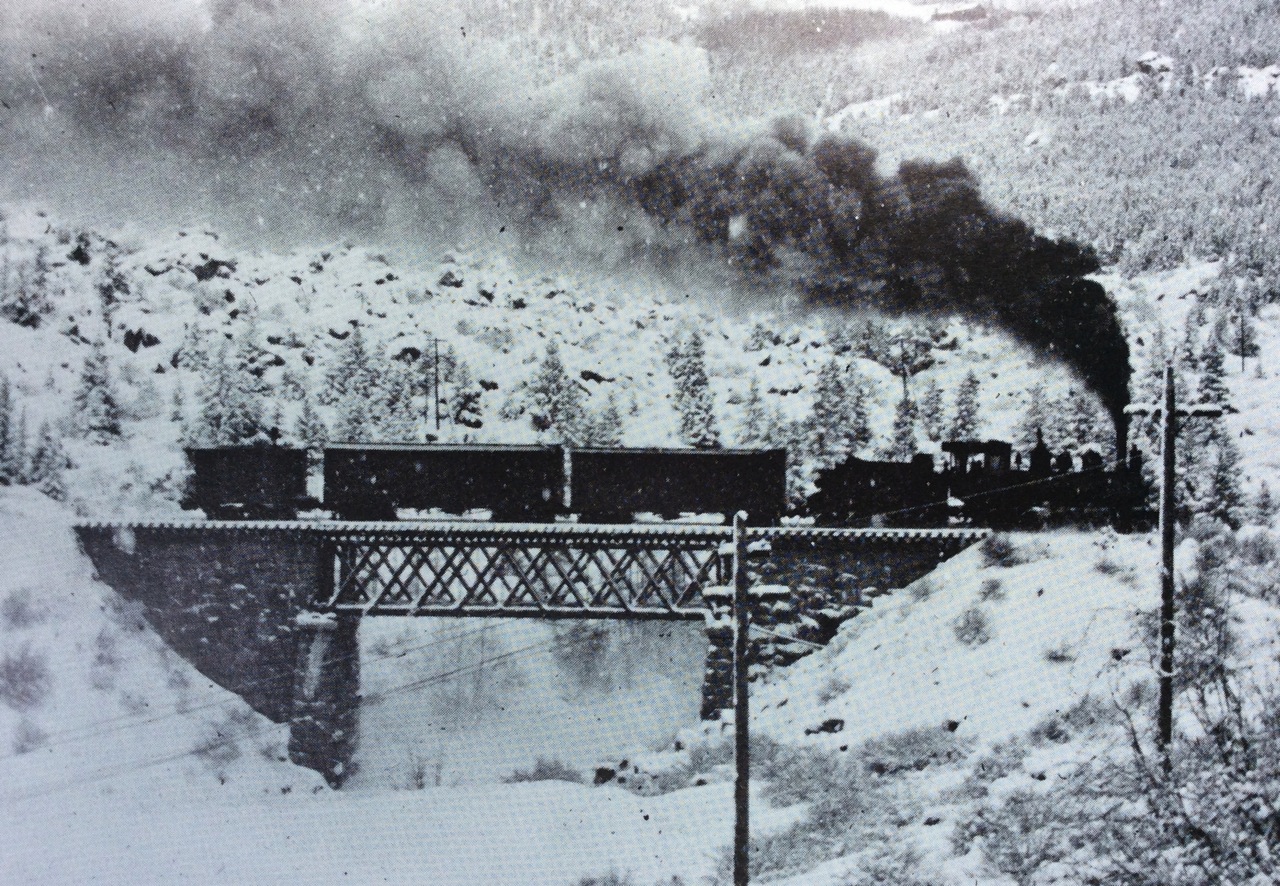 Does that look like an eight wheel caboose, or what? And, if the car in front of it is a 30 ft car, the caboose is a short-body (no more than 13 ft) car, contradicting my earlier opinion that trucks wouldn't fit under a short car. I took this from CRA 10, but they credit DPL. I can't find it there, can someone locate it for us? Probably better resolution available there. I love this snowy photo, one of my favorites. Cheers, John
John Greenly
Lansing, NY |
Re: More C&S caboose under frame weirdness.
|
In reply to this post by Chris Walker
Yes, Chris, I do think that's possible, exactly. I almost said that in my post, but wanted to hear other opinions. thanks!! John
John Greenly
Lansing, NY |
Re: More C&S caboose under frame weirdness.
|
In reply to this post by John Greenly
One thing-- with respect to the "intermediate" 9 ft undercarriage, I'm confused as to why you listed 308/1006 as having had an intermediate undercarriage. The 1006 folio shows a 9 ft wheelbase, but couldn't that be the modern undercarriage? I believe we have only the one photo of 306 with the intermediate version on the C&S and predecessors, and at the moment, no early photo that is inconsistent with the shorter 6' 3" wheelbase.
My, my John! For a guy participating in a mass conjecture, you're quite the stickler for details!  You're right, we only have one photograph for what I have labeled the "intermediate" underframe (for lack of a better term), that of 306 / 1005 taken about 1900-1901, that suggests a 9 foot underframe. But I would bet that 310 / 1008 had the same underframe applied. The two cars are so nearly identical, that I bet they were in the shops in the 1890's at about the same time, rebuilt as "twinsies". As to 308 / 1006, you may be correct. The new caboose numbering scheme was devised in 1911, applied in early 1912. So the folio of 1006 must have been updated no earlier than 1911. By that date, the car might have been completely rebuilt to the modern configuration, and the new, modern undercarriage of 9 foot wheel base annotated to the drawing--they may not have bothered changing the image (as they did on the 1007 folio)--may not have drawn in the new end cupola, nor erased one of the side windows. But they did redraw the wheels to the 9 foot wheel base! Do you remember my saying, in an earlier post, that this new information and discussion was an unwanted epiphany for me? Like you, this new information is creating problems for my model building. I'd like to have a c.1901-1909 caboose without cupola in Sn3. Overland Models produced a small run of DSP&P waycars in Sn3, along with a much larger run of various modern cabooses. The even offered a few factory painted, lettered for the C&S: 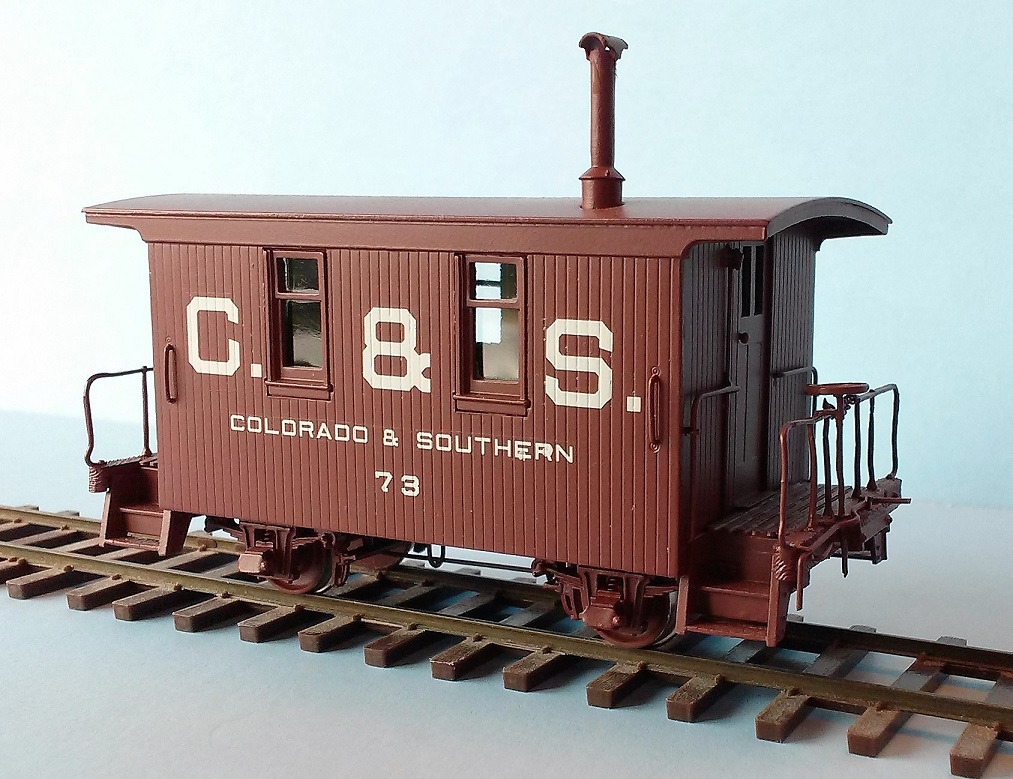 Overland did a nice rendition of the original South Park way car body, but placed it on the "modern" underframe from the other short body cabooses. The paint job was pretty good, but the block lettering seems too small for most un-rebuilt first decade cars in the few photographs available. Then they went and gave it a factory number of "73" from the 1880's, instead of a 300-series number of the first decade! Let's turn this around and see if you can suggest a new number for my "caboose that never was"; a short original body that was rebuilt with a modern underframe, but had no cupola added and had the block lettering. I have a second, unpainted Overland model that I want to convert to an earlier car, c.1901, based on the Braddocks photo, lettered with the early Roman lettering, as on the 306 photograph: 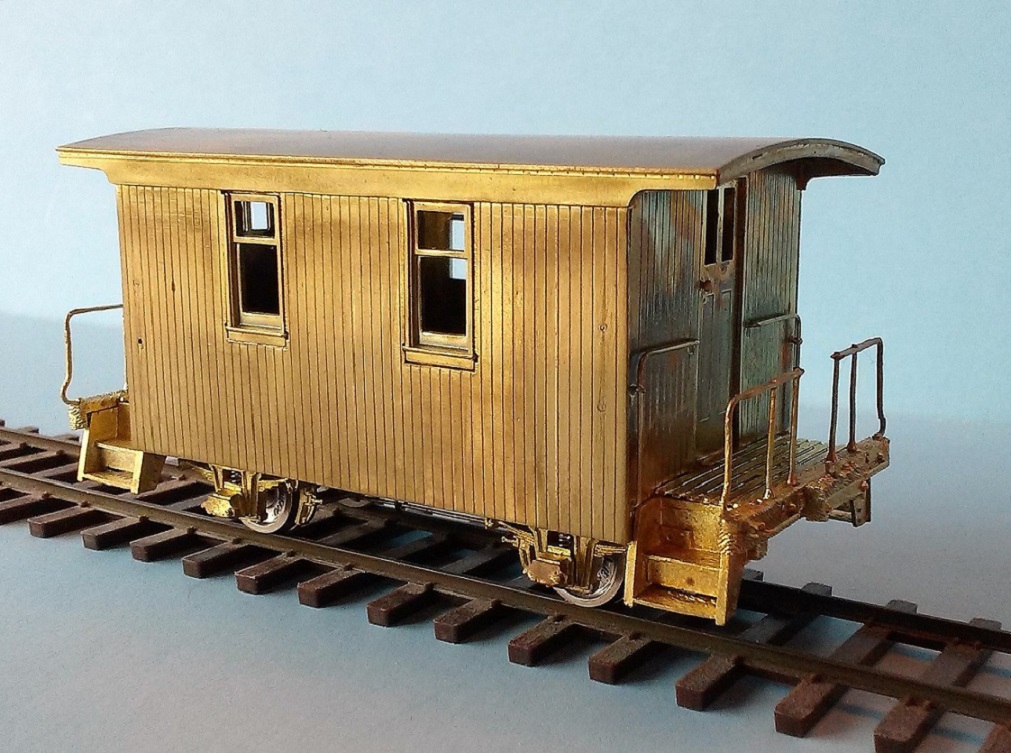 I want to redo the smoke jack and add that odd cylinder like vent on top, add curved caboose grabs to the bottom corner, and scratch build a new underframe using a 3-D printed part from a Shapeways vendor: https://www.shapeways.com/product/25UZMCDDX/dsp-p-waycar-running-gear-sn3?optionId=40675954 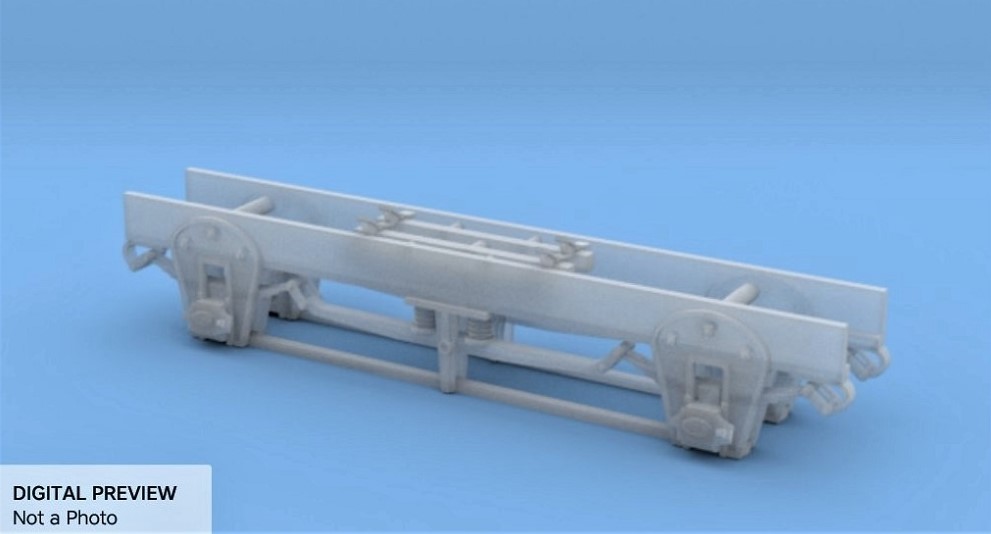 The 3-D print is of the 9 foot underframe, as under 306. If the short body cars carried original underframes until the 1908-1912 rebuild, then I'm screwed, my plan thwarted. I have no idea what the underframe looked like nor how to model it. So maybe that's why I cling to the idea that at least the 308 / 1006 had a 9 foot "intermediate" underframe applied by 1899 and well before the 1908 rebuilding program began. Self interest! I can follow my original plan and rationalize it as 306 as it appeared in 1901, based on the folio drawing alone. BTW, if any of you HOn3 modelers hanker to build a model of 306, I have a pair of HOn3 versions of the underframe print, that Shapeways printed and mailed to me by mistake. Let me know if you'd like one, I have two sets. Free--if you've bothered to wade through this long and convoluted thread. 
Jim Courtney
Poulsbo, WA |
Re: More C&S caboose under frame weirdness.
|
In reply to this post by John Greenly
Thanks John for posting that CRRA #10 picture, that was the picture I recalled with the usual nagging propensity(but couldn't find) back when Derrell was having his 8-wheel caboose quandary going, you see I got quite excited and therefore distracted once he posted the picture that we now know to be definitely at the Argo; Idaho being my main obsession.
An interesting aside, the NZR at the time(1880 decade) was building bogie Vans of 20', 22' and 30', having given up on the 4-wheelers except those needed as special Brake Vans on the centre railed incline(s).
UpSideDownC
in New Zealand |
Re: More C&S caboose under frame weirdness.
|
This post was updated on .
In reply to this post by John Greenly
UPD&G cabooses 1725 and 1726, originally CCRR 26 and 27, were built in late 1883. They were renumbered to UPD&G 61 and 62 in 1897.
When acquired by the C&S, they became 300 (later 1000) and 301 (later 1001). We know that the 1000 was a long body caboose, at least after the 1908-1910 rebuild (14' 10" body length). If both cars were built in the same batch in 1883, they were likely both the same length. If Todd's 1885-86 photo at Beaver Brook is of a long body caboose, and the rear wheel set is very near the end steps, is it possible that the caboose has already been modified to ride on a pair of trucks? Is it already an eight-wheel caboose, as you are suggesting in the snowy photo from about 1905 on the upper part of the Georgetown Loop? Remember, what started on Clear Creek, generally stayed on Clear Creek. (He asks, as all of us move collectively further out on a conjectural limb . . .)
Jim Courtney
Poulsbo, WA |
Re: More C&S caboose under frame weirdness.
|
In reply to this post by Jim Courtney
Yes, Jim,
woe is us, the benighted who persevere in modeling… I was going to say first decade, but now it seems it's most everything before 1912 or so... C&S cabooses! With respect to your latest queries, the first point that comes to my mind is, do we really have reason to assume that the modern undercarriage installation was always done at the same time the cupola addition/body rebuild was done? I'm really unsure about that. I am beginning to get boggled by all this, but at the moment I can't think of anything we have that forces us to assume this. Am I wrong? If we remove that assumption, we can take the folio of 1006 at its word (or diagram) and say that 1006 got its modern undercarriage first, and then the cupola later, in which case your Overland car could happily be 1006, or 308, during your time frame. That is more than slightly ironic, since this whole thread started off with my model that I wrongly numbered 1006! In fact, if you decouple undercarriage and cupola rebuilds then other cars might well suit too, since there is so little photographic or other evidence of exactly when they underwent either operation. For instance, 1007. It had a cupola by the folio date, but do we know that it didn't have the modern undercarriage before it got its cupola? As I asked previously, a crucial question is when did the modern undercarriage conversions start to be done? Could it have been as early as 1900? I don't know. If so, then there might be quite a nice time window, and several choices of number, for your car to exist. Going back to the 1006 folio for a moment, I wonder if is likely that it would not show a cupola if the car had one. Those overall dimensions like height really ought to be reliable, since they impact (so to speak) clearance issues out on the line. If 1006 had a cupola then, it seems that the folio really ought to show it! Given that thought, I think dubbing your model 1006 is totally justified, absent further revelations. As to my new big-block-letter flat-roofed car, the stumbling block is its round corners, which seems to restrict me to 1011 alone, now that 313 has entered the twilight zone. An aside about the big block lettering. I believe you're right, the Overland lettering is somewhat small. I used the largest Leadville Shops block lettering (Thanks again!!!) for my HO car, the height is right on with the 313 photo, but the letters were too wide to fit. They are in fact wider than in other sets I have. So I narrowed them by 3 inches by cutting them vertically and then overlapping the two halves. That makes them just about like the 313 photo. As to your unpainted car, again we come to the question, when did the modern undercarriage appear? Maybe there was a short-bodied car with it in 1901. Which is more speculative, leaving the modern undercarriage on the model, or replacing it with the "intermediate" version? I don't know. As to earlier cars, with the exceptions, during some period of time, of 306 and the eight-wheel car(s), it seems there may be a big problem: the short-wheelbase undercarriage, of a construction that we have only the faintest idea of from the 313 photo. If we could write off 313 as a unique version (we don't even really know what car it was- was it 80/1518, or not?), then given that the "intermediate" design (maybe we could call it the equalized design?) was very common on other roads, it might be justifiably speculated that the early cars would likely have used a short-wheelbase version of it. Maybe it could be found out when this type of four-wheel undercarriage was first employed on any railroad. If it goes back to 1880 or earlier, then use of a short version on the original South Park cars could be very reasonable speculation. That Shapeways part looks like it would be possible to shorten, only the curved equalizing bar would present some problem. I'd take one of your HO ones, Jim, if nobody else wants them. Don't know when I'd get to it, but I'd like to see what a model DSP&P car with a 6' 3" wheelbase would look like. Then I could post a picture of it and confound anybody who googles "DSP&P caboose". A neat little car like that might get me intrigued to build more things from the DSP&P era someday. But that would have to compete with an emerging urge to build a two-truck short-bodied car like the one on the Clear Creek Georgetown loop bridge that Chris and I like. All the discoveries in this thread are reminding me of my uncle, an artist, who always said that most people see only what they are looking for. Cheers, John
John Greenly
Lansing, NY |
Re: More C&S caboose under frame weirdness.
|
In reply to this post by Jim Courtney
Ah, great, Jim, excellent! If this is a long body caboose, then I believe you're right, it's possible there are trucks under it. I really can't tell. I need to think that through, geometrically. That would be a nice element of a very neat story for eight-wheeled cabooses! And it'd remove our exception to the short-wheelbase theory. I don't see anything to contradict it, at the moment. Out on a conjectural limb, or down a rabbit hole, either way, this is fun!! John
John Greenly
Lansing, NY |
Re: More C&S caboose under frame weirdness.
|
As to the caboose in the snowy photo at the end of the 3 car freight.
Is that daylight seen through and around individual trucks under the car, or is that white, kinda horizontal swatch, just snow accumulating on top of the air cylinder/reservoir, on the outside of an original 4-wheel underframe? I can't tell. 
Jim Courtney
Poulsbo, WA |
Re: More C&S caboose under frame weirdness.
|
I assumed that white blob is snow, or something on the car, and is not seeing all the way through to the light background. The reason I wondered if it could be trucks is that at this nearly side-on angle there should be plenty of empty space between the wheelsets of a four-wheeled car down near the railheads that we could see through to the background, as with the freight cars in the train. If this is a long-body car, then there is enough length for trucks in that dark length under the car, and reason why we can't see through, except possibly that one white dot down low, at this viewing angle.
John Greenly
Lansing, NY |
Re: More C&S caboose under frame weirdness.
|
Remember, the bottom of the individual wheels are partially hidden by the snow covered guard rails of the bridge (note the wheels of the two boxcars--we know they have individual trucks!).
Jim Courtney
Poulsbo, WA |
Re: More C&S caboose under frame weirdness.
|
This post was updated on .
Yes, certainly. The individual wheels are not visible on any of the cars. Only the empty space between trucks is seen. The caboose shows no such space. If it was four-wheeled, there should be space visible; if it has two trucks they have to be close together, and viewing at this slight angle there shouldn't be space visible between them… I think. The only other reason for there being no empty space under the middle of the car would be that something else was hung under there that blocked seeing through to the light background. I guess we can't rule that out.
John
John Greenly
Lansing, NY |
«
Return to C&Sng Discussion Forum
|
1 view|%1 views
| Free forum by Nabble | Edit this page |

